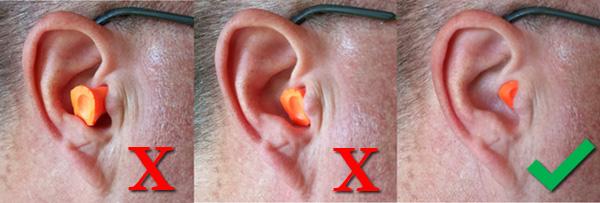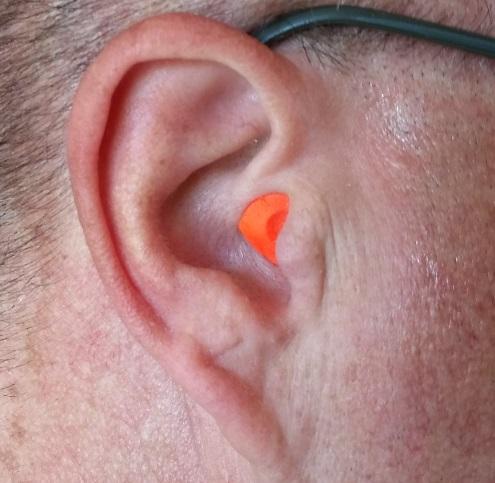Noise pollution is a growing concern in today’s society. According to the World Health Organization (WHO), exposure to loud noise can cause permanent damage to your hearing, leading to hearing loss and other hearing-related injuries. And the WHO estimates that in only thirty years, an astounding two and a half billion people are anticipated to suffer from hearing loss – with at least seven hundred million requiring further medical attention. Even more startling is that over one billion young adults face the danger of permanent, but preventable hearing damage due to bad listening habits. The use of earplugs is a simple and effective way to protect your hearing, but it’s not enough to just put the earplugs in, it’s important to wear them correctly.
As winter approaches, the use of earplugs becomes increasingly popular as many people use them to block out the sound of snowblowers and other loud winter equipment. However, it’s not just the noise from winter equipment that can damage your hearing. Exposure to loud noise in any environment, whether it’s at work or at home, can cause permanent damage to your hearing if you’re not properly protected. That’s why it’s important to use earplugs to protect your hearing, no matter what the season.
With the importance of protecting your hearing in mind, it is important to understand the right way to wear soft foam ear plugs. Not only will this ensure maximum protection but also a comfortable fit. This article aims to provide a step-by-step guide on how to wear earplugs correctly, so you can take control of your hearing health and protect yourself from the harmful effects of noise pollution. By following these simple steps, you can ensure that your earplugs are inserted properly and provide the maximum level of protection. So, be proactive and take control of your hearing health.
- Make sure your earplugs are clean and dry before you put them in. Dirty or wet earplugs can be uncomfortable and may not provide the same level of protection. It’s important to ensure that your earplugs are clean and dry before you put them in. Earplugs that are dirty or wet can be uncomfortable and may not provide the same level of protection. This is because dirt and moisture can block the ear canal and prevent the earplugs from fitting properly. In addition, if earplugs are dirty or wet, they can become a breeding ground for bacteria and cause an infection. Always check the earplugs and clean them before use, or replace them with new ones if they are dirty or wet.
- Roll the earplug between your fingers to compress it. This will make it easier to insert into your ear canal. Rolling the earplug between your fingers will compress it and make it easier to insert into your ear canal. This is because compressed earplugs are smaller in size and can be inserted with more ease. When you release the earplugs, it will expand and create a seal in the ear canal, which will block out noise. Compressing the earplugs also makes it easier to mold the earplugs to the unique shape of your ear canal for a better seal and fit.
- Reach over your head with one hand to pull your ear up and out, while holding the compressed earplug in the other hand. Reaching over your head with one hand to pull your ear up and out can help to straighten the ear canal, making it easier to insert the earplugs. By holding the compressed earplug in the other hand, you can use your fingers to guide the earplug into the ear canal. It’s important to be gentle and avoid pushing the earplug too hard, as this can cause discomfort and may not provide the best seal.
- Insert the earplug into your ear canal, making sure it goes in far enough to provide a proper seal. Inserting the earplug into the ear canal is the most crucial step, as the proper fit and seal is necessary to block out the noise. Make sure to insert the earplugs far enough into the ear canal to provide a proper seal. But be careful not to insert the earplugs too far, as this can cause discomfort or even injury. A good rule of thumb is to insert the earplugs until the flange is flush with the ear canal.
- Hold the earplug in place with your finger for a few seconds while it expands to fit the shape of your ear canal. Once the earplugs are inserted, hold them in place with your finger for a few seconds while they expand to fit the shape of your ear canal. This will ensure that the earplugs are securely in place and will create the best seal possible. It’s important to hold the earplugs in place for at least 30 seconds to allow them to fully expand and create a proper seal.
- Repeat the process with the other ear. Once the first earplug is in place, repeat the process with the other ear. It’s important to protect both ears to ensure the maximum level of protection.
- Check the seal of the earplugs by gently tugging on the earplug. If it feels loose, remove and reinsert the earplug to ensure a proper seal. It’s important to check the seal of the earplugs to ensure that they are securely in place and providing the maximum level of protection. Gently tug on the earplugs to check for a secure fit. If the earplugs feel loose, remove and reinsert them to ensure a proper seal. A proper seal will block out noise and prevent hearing loss. It’s important to check the seal of the earplugs regularly, especially if you’re in a loud environment for an extended period of time.
- Do not remove earplugs by pulling on the cord. Instead, use the tabs provided to gently twist and remove the earplugs. When it’s time to remove the earplugs, do not pull on the cord to remove them. Instead, use the tabs provided to gently twist and remove the earplugs. Pulling on the cord can damage the earplugs and make them less effective. Twisting the earplugs will break the seal and make it easier to remove them without causing discomfort. Additionally, if the earplugs do not have tabs, gently pull them straight out.

Proper and improper earplug fitting
In conclusion, wearing earplugs correctly can protect your hearing and prevent noise-induced hearing loss. It’s important to follow these steps to ensure the earplugs are inserted properly and provide the maximum level of protection. Remember, it’s not enough to just have earplugs, it’s important to wear them correctly to protect your hearing. Be proactive and take control of your hearing health.
References:










